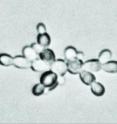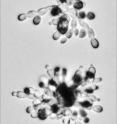How yeast makes heads or tails of itself
Yeast has been a friend to humanity since ancient times, when people first learned to harness the organism to make bread and brew beer. Yet, we don't always think of yeast as something remarkable. Instead, it's often perceived as plain or dull -- a single-celled organism that, like a plant, lacks the ability to move on its own accord.
But even the simplest creatures have their wonders, as a new piece of science shows.
Led by biologist Paul J. Cullen at the University at Buffalo, the research will be published the week of March 21, 2016 in the Early Edition of The Proceedings of the National Academy of Sciences. It highlights the remarkable adaptability of Saccharomyces cerevisiae, common baker's yeast.
Researchers previously observed that the species, which lives in colonies, can alter its pattern of growth in response to food scarcity. Starve a colony of S. cerevisiae, and new cells start growing outward in a filament-like configuration that may aid the search for nutrients.
The new study identifies the amount of time it takes for this to happen -- within 2 1/2 hours, affecting the very next generation of yeast cells born in the colony -- and also identifies the mechanism through which the changes occur.
The shift in growth patterns has to do with the mysterious concept of proprioception. In people, proprioception is like a "sixth sense" that gives us an understanding of our position and movement, says Cullen, associate professor of biological sciences in the UB College of Arts and Sciences. But how do cells "sense" their spatial orientation? That's the question the study addresses.
"All organisms have a sense of orientation," Cullen says. "Humans have a head and feet. In the stomach, cells have one side that faces inward toward the body, and another that faces out toward the stomach acid, and these two sides are very different.
"All organisms have this duality, called polarity, and it's really important for animals and cells to do what they do. But what's less clear is how we sense our orientation during day-to-day decision-making. How do organisms determine what their front and back ends are doing when things are changing? How, for example, does a cell know its head from its tail when it's dividing? We look at this question in relation to yeast."
A yeast's sense of self
In yeast, the heads-or-tails phenomenon that Cullen describes involves the direction in which a colony spawns new cells.
Under normal circumstances, existing yeast cells -- called mother cells -- give rise to daughter cells, which grow from the end of the cell that faces the colony. The resulting colony resembles a ball.
But when nutrients are scarce, this pattern reverses itself within a single generation, the study finds. During times of starvation, daughter cells start budding from the opposite end of the mother, growing away from the heart of the colony in a filament-like pattern.
Through painstaking microscopy, Cullen's team showed that this change occurred within 2 1/2 hours -- the time it takes for a yeast cell to make just one division. The work involved viewing small groups of yeast cells repeatedly under a microscope and logging their behavior over time.
Additional analyses enabled the scientists to understand what happened inside the cells to jumpstart the new growth pattern.
The researchers linked the change to proteins found on opposite ends of a yeast cell. The side of a yeast cell that faces its mother contains axial bud proteins, while the other side contains the Bud8 protein. When nutrients are high, axial bud proteins give off chemical signals that activate complex decision-making pathways within individual yeast cells. These pathways direct the cells to produce daughters facing the colony.
But when nutrients are low, Bud8 churns into gear and gives different instructions. It activates decision-making pathways that tell cells to produce daughters from the opposite end -- the Bud8 end -- which faces outward, away from the colony.
The team discovered, in essence, how yeast cells decide which way to orient themselves -- in other words, how these tiny single-celled organisms get their bearings.
"What we see is that a yeast's polarity -- the direction in which it grows -- can be attributed to the instructions it receives from Bud proteins, these spatial landmarks," Cullen says. "The Bud proteins give the cell information about what orientation it should be in, about which direction to grow. When there are lots of nutrients, there's one decision-making process that comes into play, and when nutrients are scarce, there's another. So these spatial marks help cells make decisions during filament formation."
Source: University at Buffalo
Articles on the same topic
- You can thank diverse yeasts for that coffee and chocolateThu, 24 Mar 2016, 19:45:53 UTC
Other sources
- You can thank diverse yeasts for that coffee and chocolatefrom Science DailyThu, 24 Mar 2016, 19:40:59 UTC
- You can thank diverse yeasts for that coffee and chocolatefrom PhysorgThu, 24 Mar 2016, 16:00:39 UTC
- How Yeast Makes Heads or Tails of Itselffrom Newswise - ScinewsMon, 21 Mar 2016, 21:00:45 UTC
- How yeast makes heads or tails of itselffrom PhysorgMon, 21 Mar 2016, 19:20:40 UTC

